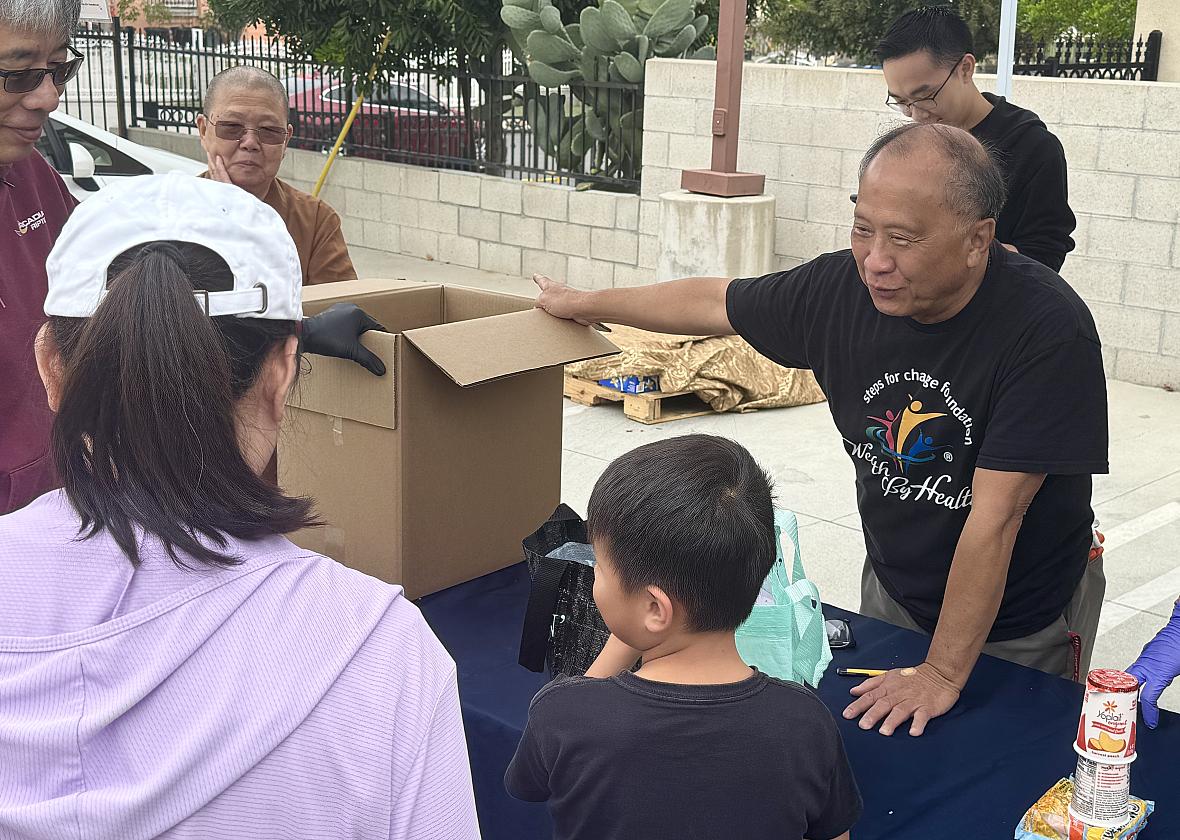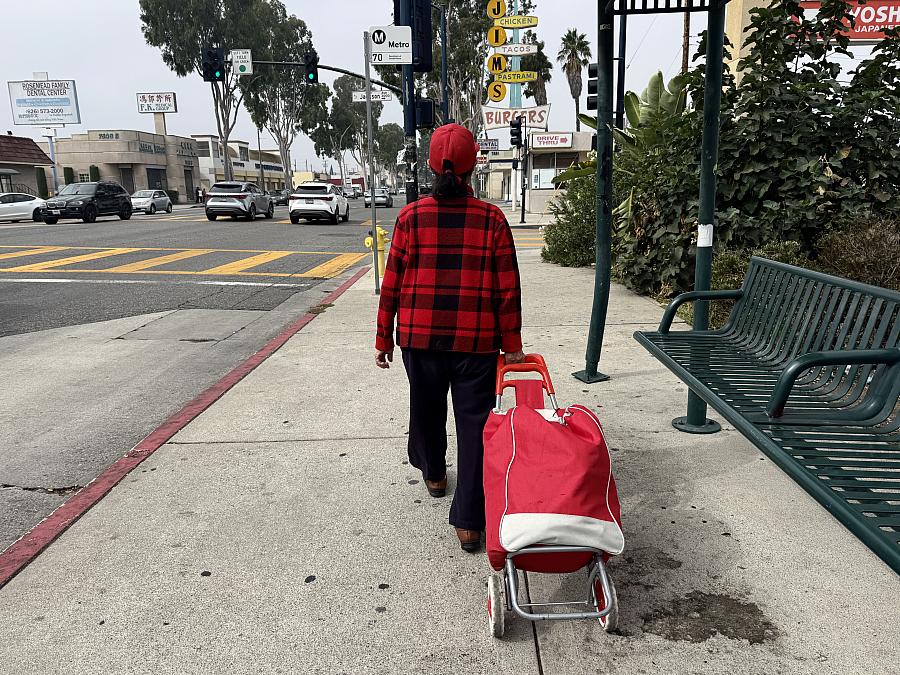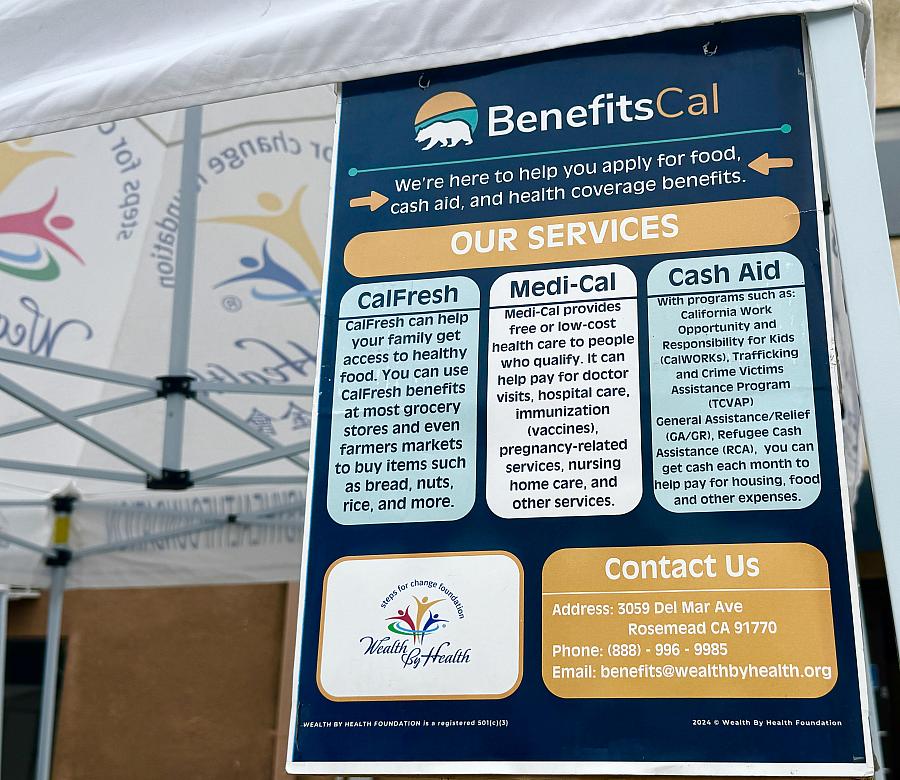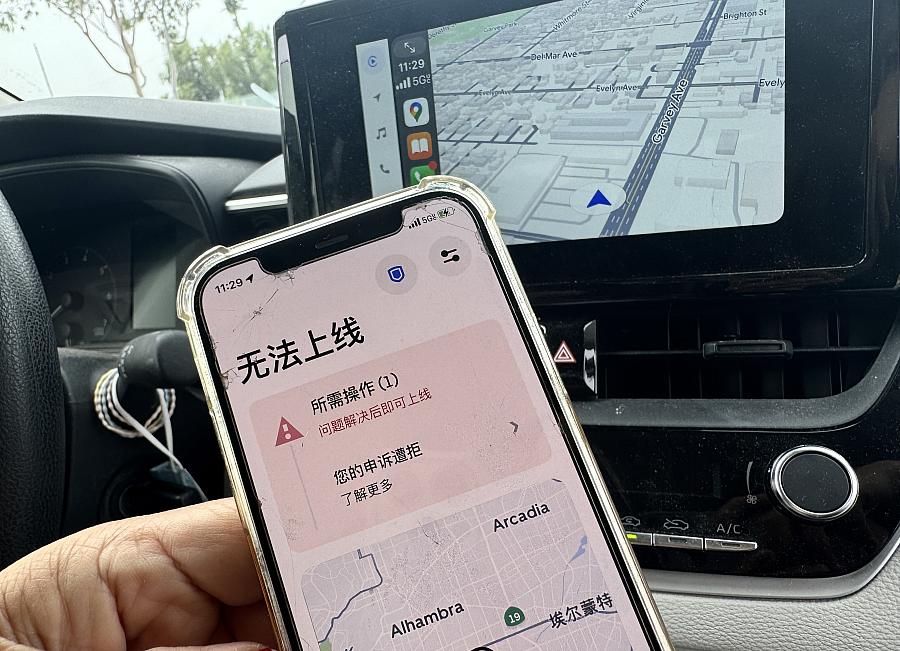Rising Rents in Los Angeles Are Driving Chinese Families to Food Pantries
The story was co-published/aired with World Journal as part of the 2025 Ethnic Media Collaborative, Healing California.

Kevin Yip, founder of Wealth by Health Foundation, a volunteer-run team based in the San Gabriel Valley, assists a parent with children at the site. Jian Zhao/World Journal
The line for free food in Rosemead, Los Angeles County, began as early as 5am — four hours before the food pantry opened.
Eighty-four-year-old Qing Hua from Alhambra had taken three buses — routes 78, 260 and 70 — to reach the parking lot behind Dharma Seal Temple Temple, where volunteers were stacking boxes of canned goods, fresh vegetables and fruit, frozen seafood, and yogurt.

Eighty-four-year-old Qing Hua with her grocery cart. Jian Zhao/World Journal
It’s 2025 in America — yet, despite the promise of better times, for many families, finding enough food is still a daily struggle. As prices climb and government aid wavers, more Chinese immigrant families in Los Angeles County are turning to food distributions for help. Language barriers and fears about their immigration status make this daily struggle even harder. And the health consequences of food insecurity are mounting: untreated chronic diseases, and mental health crises that ripple through families.
Hua spends her days caring for her daughter, now in her fifties, who suffers from schizophrenia, dementia, and multiple chronic illnesses. Their main income is an In-Home Supportive Services (IHSS) stipend Hua receives for caring for her daughter. While not a direct "stipend" for recipients, the IHSS program provides payment to IHSS providers (who are often family members) to perform care services for eligible low-income individuals who are aged, blind, or disabled. Hua says that her IHSS stipend — about $2,000 a month for roughly 110 hours of care — barely covers rent and utilities. Because of her daughter’s condition, sharing housing is not an option.
“I’ve moved 37 times in the past 30 years,” Hua said. She has been on the waiting list for subsidized housing for more than a decade.
Her daughter receives about $800 a month in disability payments through Her daughter’s Supplemental Security Income (SSI), which payments barely covers out-of-pocket medical expenses, Hua shares. Even with Medi-Cal coverage, co-pays for medications and medical supplies add up. The only steady source of food is CalFresh, California’s food-assistance program.
“We live on food stamps,” she said. “Without them, it’s impossible to survive.”
The less than $500 a month they receive from CalFresh keeps food on the table. But with the instability of Congress' actions when it comes to the SNAP program, even that lifeline is uncertain.
Public health experts warn that food insecurity directly impacts health outcomes. According to the Office of Disease Prevention and Health Promotion, adults who are food insecure may be at an increased risk for negative health outcomes and health disparities. One study found that food-insecure adults may be at an increased risk for obesity. Another study found higher rates of chronic disease among food-insecure working age adults.
When her turn finally came, volunteers placed a bag of food — fresh celery, watermelon, grapes, frozen shrimp, and flavored yogurt — into her cart. Hua smiled.
“The shrimp and fruit are for my daughter,” she said softly, almost to herself. “She’ll be happy. I’m easy to feed. I can eat anything.”
A Community Filling the Gap
The event was organized by the Wealth by Health Foundation, a volunteer-run team based in the San Gabriel Valley. Behind the tables stood college students in black T-shirts, passing out food and checking names.

The food pantry on October 25 in Rosemead. Jian Zhao/World Journal
“The numbers of people were much less last year,” said Kevin Yip, who founded the group in 2018. “Now it’s 300 to 350 families each time, and the number keeps rising.”
Each event gives away roughly 6,000 pounds of food—fresh produce, canned meat, frozen seafood, rice, and other staples donated or purchased by wholesalers or local farms at low cost. The organization also works with food banks in Los Angeles county, which inspects each site for cleanliness and storage safety every three months.
Yip said the foundation began with health-screening clinics and scholarships. But when the pandemic hit, patients started asking if they could also get food. “At first it was just a few boxes from temple donors,” he said. “Then we realized the need wasn’t going away.”

Volunteers from Wealth by Health Foundation. Jian Zhao/World Journal
He noted they now receive at least 30 calls a day, compared to three or four calls last year. “People tell us they lost jobs, or their hours were cut, or rent went up.”
The group’s volunteers organize the food distribution bi-weekly, and also help low-income families to apply for CalFresh and other benefits on site.

The benefits application booth at the Rosemead site. Jian Zhao/World Journal
In late October Yip’s team received a notice saying CalFresh November benefits payment – the monthly food funds loaded onto EBT cards, were going to be delayed due to the ongoing federal government shutdown.
According to the California Department of Social Services, beneficiaries can still access existing funds on their EBT cards, but the timing and amount of any November payment “are unknown at this time.”
“We’re still helping people apply,” he said, “but we don’t know what will happen next month.”
According to Yip, the foundation has helped file about 200 CalFresh applications this year — a 30 percent increase from last year — with more young adults among the applicants.
Rising Costs, Shrinking Options
At the Rosemead site, from elderly retirees to mothers with young children and office workers, all are struggling with the same math: rising living costs and stagnant wages.
Lin (last name withheld), who worked for a trade company for five years, was laid off this summer when the entire department was cut. Her unemployment check is $450 a week. “With rent, it’s not enough,” she said. “I never thought I’d have to apply for food aid.”
Lan, a mother of three, said the rent for her family’s shared apartment jumped from $1,400 to $2,000 in just two years. “Both of us work full-time, but with medical and car insurance, we can’t keep up,” she said. “We work hard, but everything costs more.”
According to the U.S. Bureau of Labor Statistics, consumer prices rose 3.0 percent over the 12 months, while groceries (food at home) were up 2.7 percent and gasoline jumped 4.1 percent in September alone. Meanwhile, Los Angeles County tenants remain heavily rent-burdened — 77% of extremely low-income households in Los Angeles County are paying more than half of their income on housing costs, according to a 2024 report.
The volunteers said the demographic has changed: “We still see seniors, but now more young people.”
“I Study Hard So I Can Buy a Lot of Snacks”
For some new immigrant families, the squeeze is compounded by fear. They worry it will affect their immigration status.
Tree Wang, a widowed single mother with two daughters from Temple City, is one of them.
Around 11 a.m., as volunteers finished cleaning up, Wang stopped her car near the site and asked, “Is this where people pick up food?”
In the back seat sat her 11-year-old daughter.
Unfortunately, they had missed the event by minutes. “I hesitated to come,” Wang admitted. “It’s embarrassing. I'm afraid someone I know sees me.”
She has another daughter,19, in college.To support her two children, Wang has been driving for Lyft, Uber, and Instacart, taking any order she can get. But she has been out of work for two months.
“My driver accounts were suspended,” She said. with a dysfunctional cell phone and language barrier, she often faced misunderstandings with customers, leading to complaints. “The platforms always side with the customer first,” she claimed.

Tree Wang’s driver accounts were suspended. Jian Zhao/World Journal
Her younger daughter, G., was often her interpreter during deliveries, witnessing many unpleasant encounters. She once asked her mother “Why do people always treat us this way?”
G. could translate, but she was too young to help resolve disputes and solve problems for her mother.
Inside Wang’s car were clothes, lunch boxes from the church, and crushed bottles and cardboard boxes scattered. “I collect them for cash,” she said. “There’s no food at home.”
She avoids applying for any public benefits, fearing it could affect her immigration case. “I’ve already spent more than ten thousand dollars on my immigration application," she said. “I can’t afford any risks.”
“I have no American Dream,” she added. “I have a ‘Daughter Dream’ — I just hope they can live here.”
G. sat quietly in the passenger seat. “She studies hard,” Wang noted.
When asked what she hoped studying could change, G. replied, “I want to study hard so that one day I can buy a lot of snacks.”
At school, classmates tease her for not bringing any snacks to share.

Need Food or Support?
Here are resources available to California residents:
Find Food Near You
- California Association of Food Banks — Search for local food banks and free meal programs by ZIP code. cafoodbanks.org/find-food
Apply for Food Benefits
- CalFresh (California’s food-assistance program) — Check eligibility and apply for monthly grocery benefits online. getcalfresh.org/en/faq
Community Hotlines
211 LA County — Call 2-1-1 for multilingual help finding food, housing, or health services. 211la.org
This project was supported by the USC Annenberg Center for Health Journalism, and is part of “Healing California”, a yearlong reporting Ethnic Media Collaborative venture with print, online and broadcast outlets across California.

